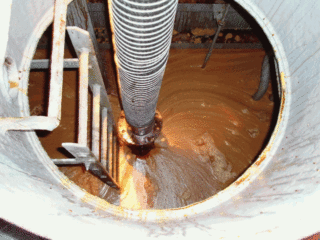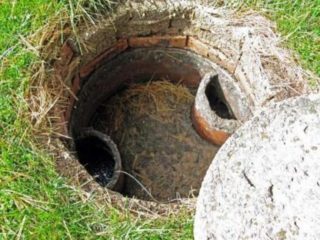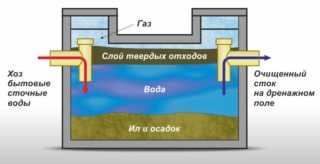A cesspool is a phenomenon characteristic of country houses in an area devoid of any kind of sewage system. The device for collecting human waste in a country house or in a private house is not complicated, but it needs appropriate care. There can be several problems, such as flooding with water or filling with silt. It is desirable to solve them in time, or better, to anticipate, otherwise you can lose even such a simple design for collecting waste.
The principle of operation of the cesspool
A drain pit is essentially a reservoir recessed into the ground. Its wall walls can be made of a concrete layer, brick or reinforced concrete rings of large diameter. The design must necessarily include a technological hatch through which sewage is pumped out. A drain pipe leading from the catering unit is lowered into the tank. Another element is the ventilation pipe. If we neglect its installation, then gases from sewage will accumulate in the pit, creating an unpleasant smell from which a person can lose consciousness, this gas is explosive. The fact is that human feces and not only, when rotting, emit methane - a useful, but dangerous gas. There is even a technology for producing methane from the contents of cesspools and waste from domestic animals on large farms.
The reasons for the appearance of sludge and the first accompanying signs
Secondly, the pit can become silted as a result of poor performance of bacteria processing sewage or the complete absence of these microorganisms in it. If a septic tank has already appeared in the house, then it must be maintained correctly, that is, it must be populated and fed on time with bacteria that process sewage.
The third reason for the rapid siltation is improper pumping of the filled hole. The fact is that if the tank is completely cleaned, then the walls and floor will be covered with a quickly dried crust of sewage. It creates an impermeable layer that does not allow moisture to go into the soil, as a result of this state, rapid siltation occurs. That is why, an experienced goldsmith, when pumping out the contents of the cesspool, we leave a small layer of liquid at the bottom.
Silting symptoms appear rather quickly. This is an increase in the unpleasant odor, and the rapid filling of the pit, and visual observation of the sludge on the walls.
Sludge disposal methods

- Mechanical. This method involves mechanical removal of sewage using a pump pump, bucket, brush. This procedure is carried out by a goldsmith or, in modern language, a flusher. A machine equipped with a pump will pump out the contents of the pit, and a sewer will clean the walls of silt. In this case, further disposal is carried out by specialists. After pumping out, the pit is filled with water, which is pumped out completely. Thus, the container is washed.
- Chemical cleaning method. This method can be applied independently, without the involvement of specialists. The meaning of such cleaning is to fill in one of the active substances - nitrates, ammonium or acid.You can also use formaldehyde, but the fumes will become deadly poisonous, so it is better not to use this substance when cleaning yourself. The chemical cleaning process is extremely simple. The required amount of nitrates or other substance is poured into the pit for 6-8 hours. After that, the faecal masses become liquid and homogeneous, which allows them to be pumped out with an ordinary household pump, for example, for swimming pools. You cannot use this method if the pit is made of plastic, that is, it is a septic tank. In this case, the chemicals will dissolve the walls of the container.
- Biological cleaning method. It involves the use of living bacteria of a certain type, capable of processing the contents of a cesspool. Bacteria can be aerobic, meaning they can live without oxygen, and anaerobic bacteria that need oxygen. The cleaning process is just as simple - bacteria are launched into the pit, some species must be dissolved in water before that. After that, they begin their work, which takes 3 to 10 days. The resulting liquid is biologically safe and can be pumped out with a conventional pump. In the future, new bacteria need to be launched into the empty pit, they will process waste constantly. In winter, this cleaning method does not work, since microorganisms are able to live and work only at temperatures above 10 degrees.
Each method has positive and negative sides, for example, the mechanical method is characterized by increased stench and pollution, but it is much cheaper than the others. With the chemical method of cleaning, the liquid from the pit is pumped out well, but it cannot be used as fertilizer, but this technique is applicable at any time of the year. After bacteriological purification, the slurry is a good fertilizer. The downside of this method is that bacteria can die from frost or simply from hunger. That is, if, for example, a summer cottage is rarely used, then there is very little food for bacteria in the cesspool.
Prevent siltation
Even a simple mechanical cleaning is a rather expensive undertaking, it involves the use of special machines and the labor of 2-3 people. That is why it makes sense to take a number of measures aimed at preventing the silting up of the cesspool. Also, we must not forget that the fumes are dangerous to human health, and in some cases they are fraught with the likelihood of fire.
- To prevent the pit from silting up, you need to regularly pour clean water into it, thereby reducing the concentration of fecal masses, and therefore preventing the formation of a fatty film on the walls.
- The biological method of purification is the most effective and less expensive in comparison with other methods. That is why it can be used as a prevention of siltation.
- Situations should not be allowed when the cesspool is filled to the very top. You need to clean it at about half fullness.
- After each pumping out, it is imperative to rinse the pit with water while cleaning the walls.










